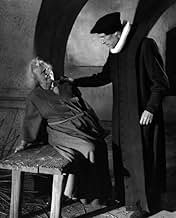ÉVALUATION IMDb
8,1/10
12 k
MA NOTE
Ajouter une intrigue dans votre langueThe young wife of an aging priest falls in love with his son amidst the horror of a merciless witch hunt in 17th-century Denmark.The young wife of an aging priest falls in love with his son amidst the horror of a merciless witch hunt in 17th-century Denmark.The young wife of an aging priest falls in love with his son amidst the horror of a merciless witch hunt in 17th-century Denmark.
- Prix
- 1 victoire et 1 nomination au total
Thorkild Roose
- Rev. Absalon Pederssøn
- (uncredited)
Sigrid Neiiendam
- Merete (Absalon's mother)
- (uncredited)
Albert Høeberg
- The Bishop
- (uncredited)
Preben Neergaard
- Degn
- (uncredited)
Anna Svierkier
- Herlofs Marte
- (uncredited)
Olaf Ussing
- Laurentius
- (uncredited)
Commentaire en vedette
Just borrowing a phrase with my summary, and not trying to trivialize "Day Of Wrath", an extraordinarily powerful film. I think we in the States are not used to films as masterfully done and as impactful as this one.
In the 17th century - Europe as well as in the States - witchcraft and witch hunts were all the rage, an age of ignorance during the Age Of Enlightment. How quaint and simplistic a notion that someone could be a witch just by anothers accusation! Director Carl Dreyer brings this idea home to us in this methodical masterpiece in harrowing detail. His story centers on a young Danish woman who goes from mouse-wife to temptress to doomed heroine. She is surrounded throughout the picture by hypocrisy and narrow-mindedness and in the end she succumbs to Christian ideals, the same ones she had been struggling to suppress for most of the picture.
You can watch until your eyes drop out and you won't find a scene not executed to perfection in all departments. I am not familiar with the actors but they were outstanding down to the smallest part. The pacing, like a Bergman film, is slow and deliberate, much the same way it would have been lived out in the 1600's. The Inquisition-type scene involving the old accused woman is even slower still, making the scene all the more horrifying, even though the torture is in the viewers mind and not on screen. Note how slowly the camera pans around the chamber of judges.
There are so many scenes worth mentioning, but it's best to see the picture for yourself if you haven't. It is an unforgettable treatment of nasty, unsavory material.
In the 17th century - Europe as well as in the States - witchcraft and witch hunts were all the rage, an age of ignorance during the Age Of Enlightment. How quaint and simplistic a notion that someone could be a witch just by anothers accusation! Director Carl Dreyer brings this idea home to us in this methodical masterpiece in harrowing detail. His story centers on a young Danish woman who goes from mouse-wife to temptress to doomed heroine. She is surrounded throughout the picture by hypocrisy and narrow-mindedness and in the end she succumbs to Christian ideals, the same ones she had been struggling to suppress for most of the picture.
You can watch until your eyes drop out and you won't find a scene not executed to perfection in all departments. I am not familiar with the actors but they were outstanding down to the smallest part. The pacing, like a Bergman film, is slow and deliberate, much the same way it would have been lived out in the 1600's. The Inquisition-type scene involving the old accused woman is even slower still, making the scene all the more horrifying, even though the torture is in the viewers mind and not on screen. Note how slowly the camera pans around the chamber of judges.
There are so many scenes worth mentioning, but it's best to see the picture for yourself if you haven't. It is an unforgettable treatment of nasty, unsavory material.
- GManfred
- 6 juill. 2011
- Lien permanent
Histoire
Le saviez-vous
- AnecdotesThere was a gap of eleven years between this film and Dreyer's last feature, being Vampyr in 1932.
- GaffesThe film is set in 1623. But at the back of the main room, where much of the action takes place, is a large wooden chest with a Latin inscription: "Quodque parum novit nemo docere potest - Anno 1639."
- Citations
Anne Pedersdotter: I see through my tears, but no one comes to wipe them away.
Meilleurs choix
Connectez-vous pour évaluer et surveiller les recommandations personnalisées
- How long is Day of Wrath?Propulsé par Alexa
Détails
Box-office
- Brut – États-Unis et Canada
- 7 642 $ US
- Durée1 heure 37 minutes
- Couleur
- Mixage
- Rapport de forme
- 1.37 : 1
Contribuer à cette page
Suggérer une modification ou ajouter du contenu manquant













